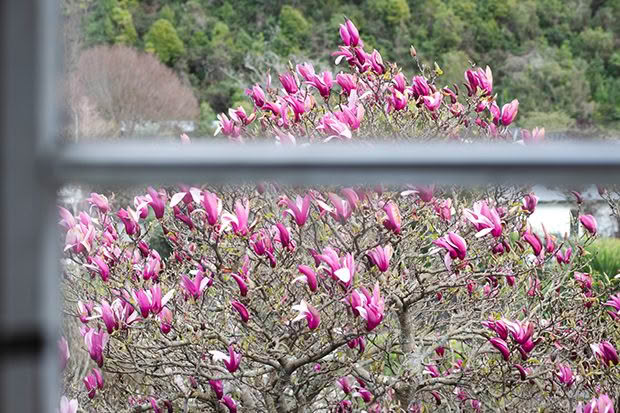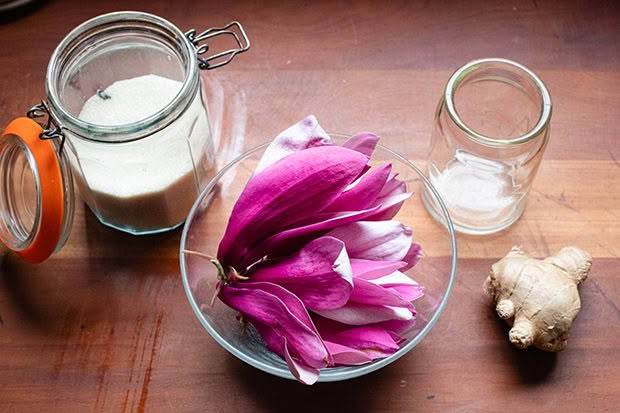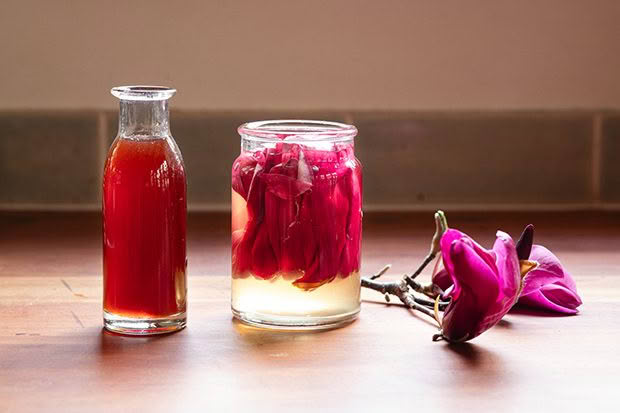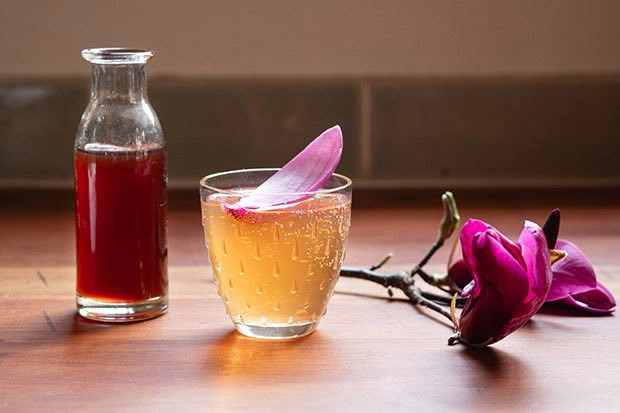Nicola Galloway: The underrated delight of magnolia petals

Did you know you can eat magnolia petals? Nicola demonstrates two gorgeous ways to do so.
A large magnolia tree fills the view from my kitchen window. Its trunk growing through our deck which has been carefully built (and rebuilt) around it. The age of the tree is unknown but it must be quite old as the trunk is wide and gnarled limbs well established. It made for the best climbing tree when my children were younger.
As I look out the kitchen window each day this beautiful tree clearly represents the unfolding of the seasons. In summer its dense green canopy provides much needed shade over the deck where we eat many alfresco meals. Then autumn arrives and the leaves turn colour and begin to fall. An almost daily task involves sweeping the fallen leaves into a large bag to be used as a carbon addition in the compost over winter.

Winter bares the limbs, letting welcome light into the kitchen. Even in this striped-backed state the tree is still beautiful with curved limbs reaching out in all directions. Then, as if on cue, the first magnolia buds begin to bloom as the season changes to spring. Followed a few weeks later by shoots of an iridescent green that magically grow into summer’s dense canopy. And so the cycle continues.
Some years ago I discovered that magnolia petals are edible (this article includes more details and a list of known edible varieties). It is the larger petalled varieties that are generally consumed, such as magnolia liliflora, the variety growing outside my kitchen window. When selecting flowers to use, choose younger petals without any discolouration. Eaten raw they have quite a bitter taste but pickled or used in a sweet syrup the flavour softens with hints of ginger and floral notes. Here are a few simple preparations.
Quick Pickled Magnolia Petals

Pickled magnolia petals are easy to make. They can be added to salads, and some people suggest using them as you would pickled ginger for sushi.
Gather 3-4 cups of magnolia petals, removing the stamen as this is particularly bitter. Place the petals into a colander and pour over a kettle of boiling water to blanch and wilt the petals. Gently press out excess liquid and pack the blanched petals into a 250ml jar. In a saucepan combine ½ cup apple cider vinegar (can also use rice vinegar), ¼ cup water, 1-2 tablespoons sugar and ½ teaspoon salt. Bring to a simmer then remove from the heat to cool for 5 minutes. Pour the vinegar mixture into the jar to cover the petals. Secure the lid and leave to cool. Store in the fridge and use within 2 weeks. The leftover pickling vinegar can be used as a salad dressing by combining 1:1 with olive oil.
Magnolia & Ginger Syrup

This delicately floral syrup can be used as a cordial, or as a mixer with gin or vodka. A little goes a long way. It can also be used as a syrup to spoon over a light vanilla cake or sponge.
Makes: about 300ml
INGREDIENTS
2 cups magnolia petals, packed
4 cm fresh ginger root, thinly sliced
½ cup sugar
1 cup boiling water
METHOD
Wash the magnolia petals carefully and lay on a clean tea towel to dry. Roughly chop the petals and layer with the sliced ginger into a jug or 400ml jar.
Place the sugar and water into a small saucepan and bring to a simmer. Pour the hot sugar syrup into the jar to cover the chopped petals. Cover and leave to cool and infuse for 1 hour.
Strain through a sieve, using the back of a spoon to press out the syrup.
Decant into a bottle and store in the fridge. Use within 1 month.
Serve as a drink syrup using 1 tablespoon of syrup per glass topped up with soda water and a squeeze of lemon. Or spoon 2-3 tablespoons over a light cake and top with cream and fruit.

